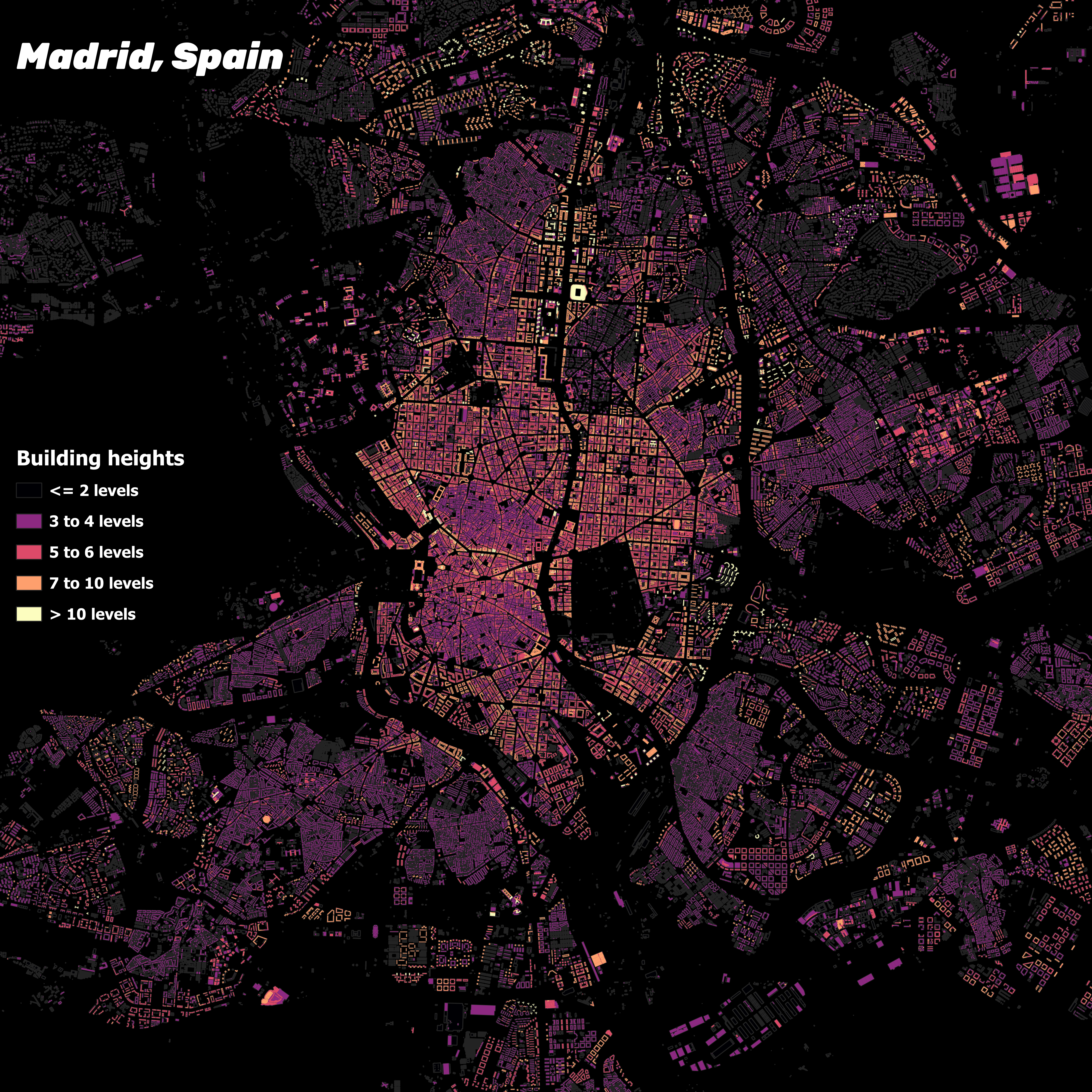Building Heights in Madrid, Spain Map


Alex Cartwright
Senior Cartographer & GIS Specialist
Alex Cartwright is a renowned cartographer and geographic information systems specialist with over 15 years of experience in spatial analysis and data...
Geographic Analysis
What This Map Shows
The "Building Heights in Madrid, Spain Map" provides a comprehensive overview of the vertical landscape of Madrid, showcasing the heights of various buildings across the city. This visualization allows users to easily identify the tallest structures, the more modest buildings, and how these heights contribute to the overall skyline and urban identity of Madrid. The data utilized in this visualization is sourced from Madrid's Geoportal, which provides accurate and updated information about the city's architectural landscape.
When we think about cities, we often picture their skyline—the iconic silhouettes that define their character and charm. Madrid, the vibrant capital of Spain, boasts a diverse range of building heights that reflect its rich historical evolution and modern architectural trends. This map is not just a visual representation; it tells a story about urban planning, development, and the city's architectural heritage.
Deep Dive into Building Heights in Madrid
Building heights are a critical aspect of urban geography, influencing factors such as population density, urban sprawl, and even local climate. In Madrid, the range of building heights varies significantly, with residential, commercial, and historical structures all contributing to a unique urban fabric. The tallest buildings in Madrid, such as the Torre de Cristal and Torre Cepsa, soar to impressive heights of over 200 meters, marking the city as one of the key financial hubs in Europe. These towering structures not only provide office space but also symbolize economic growth and modernity.
Interestingly, Madrid's urban planning regulations dictate maximum building heights in different zones, reflecting a balance between development and the preservation of historical significance. For instance, areas like the Gran Vía, known for its early 20th-century architecture, feature buildings that are generally lower than those in the financial district. This juxtaposition of old and new highlights the city’s ability to evolve while respecting its historical roots.
Did you know that the average height of buildings in Madrid is around 20 meters? However, this average varies widely across different neighborhoods. In districts like Chamartín, where high-rise developments are more common, the average height can reach 30 meters or more. In contrast, the historic areas, such as La Latina or Malasaña, often have buildings that rarely exceed four or five stories, creating an intimate, human-scale environment.
Moreover, building heights can also influence microclimates within the city. Tall buildings can create wind tunnels and shade, affecting local temperatures and wind patterns. This aspect is particularly important in a city like Madrid, where summer temperatures can soar. Understanding the implications of building heights helps urban planners design better, more sustainable cities that accommodate both people and the environment.
Regional Analysis
Analyzing the data presented in the building heights map reveals intriguing regional variations throughout Madrid. For example, in the central area, especially around the Gran Vía and the Plaza de Cibeles, buildings tend to be taller and more modern, reflecting a bustling commercial atmosphere. These areas are characterized by vibrant street life and heavy foot traffic, where high buildings accommodate shops, offices, and entertainment venues.
On the other hand, neighborhoods like Retiro and Arganzuela showcase a different skyline. Here, you'll find a mix of mid-rise apartment buildings and charming historical structures. The contrast is striking; where some areas are dominated by glass and steel, others offer a glimpse into Madrid's past with their lower, traditional facades. This mix not only adds to the city’s aesthetic diversity but also influences property values and the desirability of living in different parts of the city.
Interestingly, the outskirts of Madrid present a different picture entirely. As you move away from the city center, the height of buildings decreases significantly, with residential areas consisting primarily of detached houses and small apartment blocks. This suburban sprawl reflects changing demographics and the increasing trend of families seeking quieter living environments outside the bustling urban core.
Significance and Impact
Understanding building heights in Madrid is crucial for several reasons. First, it impacts urban planning and zoning regulations, which are essential for managing growth and ensuring sustainable development. With increasing population density in urban centers, cities like Madrid must carefully consider how to accommodate growth without compromising quality of life.
Furthermore, building heights affect the city’s visual identity and cultural significance. The skyline is often a reflection of a city’s history and aspirations, and in Madrid, the blend of modern skyscrapers with historical buildings tells a compelling story of progress and tradition coexisting.
Looking ahead, the trend of increasing building heights is likely to continue, especially in response to economic demands and the need for housing in urban areas. However, it’s essential to balance this growth with considerations for historical preservation and environmental sustainability. The ongoing dialogue about building heights in Madrid is not just about architecture; it's about shaping the future of a city that thrives on its rich history while embracing modernity.
Visualization Details
- Published
- August 12, 2025
- Views
- 128
Comments
Loading comments...